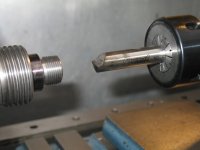mrriggs
Aluminum
- Joined
- Nov 30, 2009
- Location
- Vancouver, WA, USA
I tried to search "D-bit" but it told me there were no matches, which is odd since I saw it mentioned several times when I searched "taper reamer".
What I want to do is ream the ID of some DOM tubing to a 2.25"/foot taper, roughly 1" deep and 1" ID at the large end. I'm making sleeves to fit the taper on the end of a motorcycle crankshaft and will be doing the work on a turret lathe. The closest off-the-shelf taper reamer I can find is 2"/foot. Before I shell out the money for a custom reamer, I'd like to make a handful of parts to test the market.
D-bits were mentioned in other threads but with little detail on how to make them. In one post it said to turn a bar to the desired taper then mill off half of it. That sounds easy enough but how do you put a relief on it? Does it need it? How well will a D-bit made from O1 work on the steel tube? Could I get 10 parts out of it?
What I want to do is ream the ID of some DOM tubing to a 2.25"/foot taper, roughly 1" deep and 1" ID at the large end. I'm making sleeves to fit the taper on the end of a motorcycle crankshaft and will be doing the work on a turret lathe. The closest off-the-shelf taper reamer I can find is 2"/foot. Before I shell out the money for a custom reamer, I'd like to make a handful of parts to test the market.
D-bits were mentioned in other threads but with little detail on how to make them. In one post it said to turn a bar to the desired taper then mill off half of it. That sounds easy enough but how do you put a relief on it? Does it need it? How well will a D-bit made from O1 work on the steel tube? Could I get 10 parts out of it?





